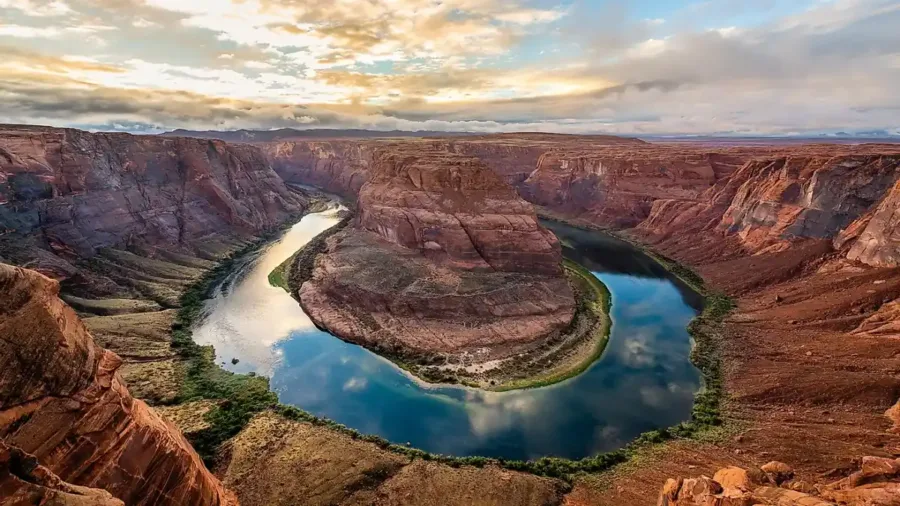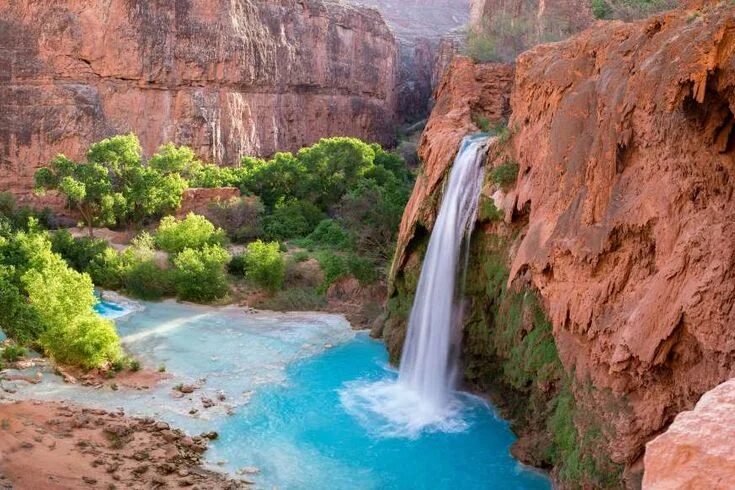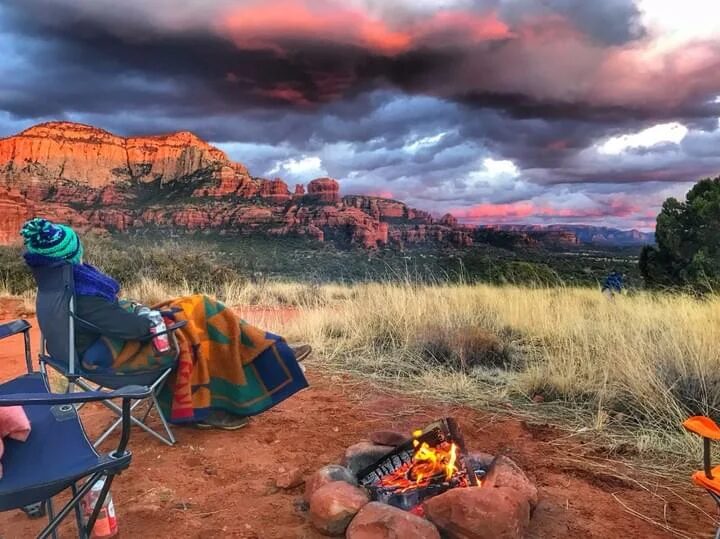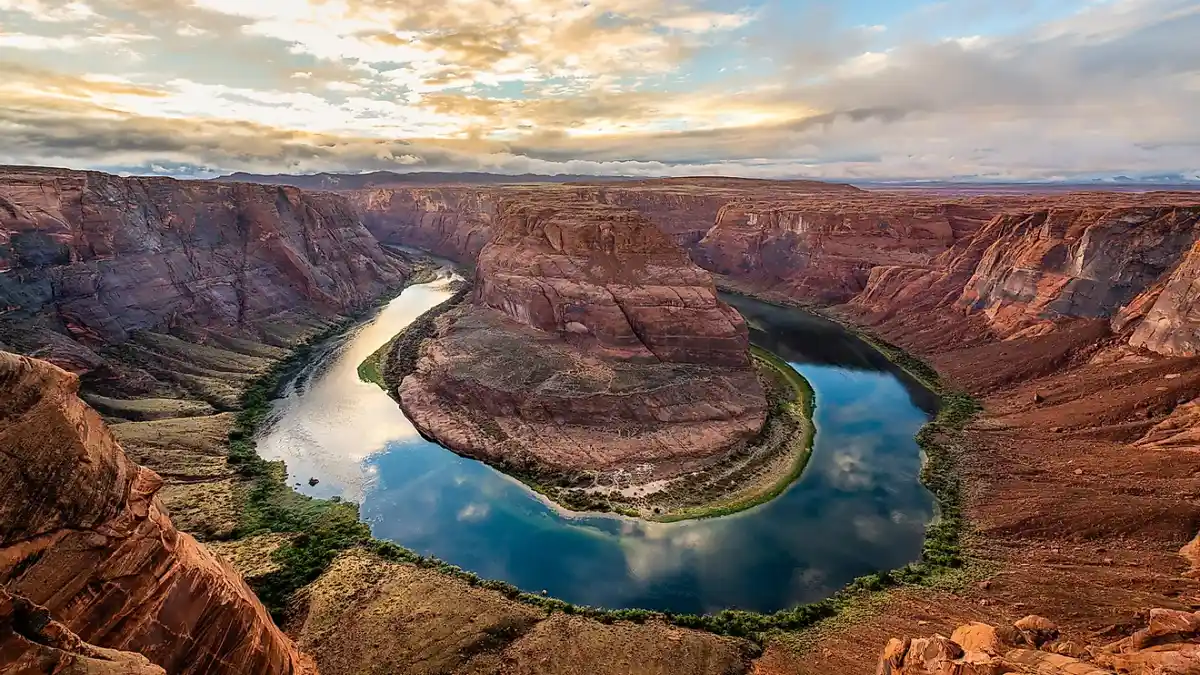Grand Canyon
The Grand Canyon National Park is a true marvel of nature, a colossal masterpiece carved by the hands of time. Its size and awe-inspiring beauty draw visitors from across the globe to witness its breathtaking grandeur. In this article, we’ll embark on a journey through this iconic landmark, exploring its geological history, captivating vistas, and the myriad adventures it offers to all who are fortunate enough to stand on its rim. It’s a testament to the Earth’s profound and enduring beauty. So, let’s venture into the heart of the Grand Canyon, where every step is a glimpse into the Earth’s own narrative.
Grand Canyon National Park Visitor Center
The Grand Canyon National Park boasts multiple visitor center’s, each offering invaluable information to enhance your experience. The South Rim features the main visitor center near Mather Point, providing orientation, exhibits, and park-related details. Another vital stop is the Desert View Watchtower. On the North Rim, the visitor center near the Grand Canyon Lodge serves as the primary information hub. These visitor center’s are excellent starting points for understanding the Grand Canyon’s geological wonders, trail recommendations, and current park conditions. For the latest details, visit the official Grand Canyon National Park website.
Grand Canyon History
The history of the Grand Canyon is a fascinating journey through millions of years. The Grand Canyon’s formation began nearly two billion years ago, with the Earth’s shifting and the Colorado River gradually carving out the deep chasm. Indigenous peoples, including the Havasupai, Hopi, Navajo, and Hualapai, have inhabited the area for centuries, their cultures deeply rooted in this magnificent landscape.
In 1540, Spanish explorers arrived, followed by American expeditions in the 19th century, leading to increased exploration and eventual protection. President Theodore Roosevelt declared the Grand Canyon a national monument in 1908, recognizing its significance. Later, in 1919, it was designated as a national park, securing its preservation.
Today, the Grand Canyon stands as a geological treasure, a testament to the power of erosion and the enduring beauty of nature. Its history, both ancient and recent, is woven into the fabric of American conservation and remains a global symbol of natural wonder and awe.
Grand Canyon Facts
The Grand Canyon is a geological marvel with a rich history. Here are some fascinating facts:
- Age and Formation:The Grand Canyon is around 6 million years old, carved by the Colorado River.
- Immense Size:It stretches for 277 miles, reaching up to 18 miles in width, and plunges to a depth of over a mile.
- Geological Layers:The canyon exposes nearly two billion years of Earth’s geological history, showcasing rock layers and fossils from different eras.
- Native Inhabitants:Indigenous tribes like the Havasupai, Hopi, and Navajo have lived in the area for centuries.
- National Park Status: In 1919, the Grand Canyon was designated as a national park, preserving its natural beauty.
- Unique Wildlife:The park is home to diverse wildlife, including California condors, bighorn sheep, and a variety of reptiles and birds.
- Weather Extremes: Temperatures can vary dramatically, from scorching heat in the summer to frigid winters at higher elevations.
- Visitation:It attracts over 6 million visitors annually, making it one of the most visited national parks in the United States.
These facts only scratch the surface of the Grand Canyon’s vast geological, historical, and ecological significance.
Grand Canyon National Park Hours
The Grand Canyon National Park typically operates with varying hours depending on the season. During the summer months, which run from late May to early September, the South Rim is open 24 hours a day. However, services like visitor center’s and shops may have more limited hours. The North Rim, on the other hand, is generally accessible from mid-May to mid-October, with visitor facilities open from early June to mid-October. In the winter months, from late November to mid-February, some services on the South Rim are scaled back or closed entirely, but the park remains open for visitors. It’s advisable to check the official Grand Canyon National Park website for the most up-to-date information on park hours.
Things to do in Grand Canyon South Rim

The South Rim of the Grand Canyon offers a plethora of activities for visitors to enjoy. Here are some of the top things to do:
- Scenic Overlooks: Take in the awe-inspiring views from iconic points like Mather Point, Yavapai Point, and Hopi Point.
- Hiking: Explore the numerous trails, from easy walks along the rim to more challenging hikes like the Bright Angel Trail and South Kaibab Trail.
- Ranger Programs: Join ranger-led programs to learn about the park’s geology, history, and wildlife.
- Visitor Center’s: Explore the exhibits and get valuable information at the Grand Canyon Visitor Center and the Yavapai Geology Museum.
- Mule Rides: Embark on a unique adventure by taking a mule ride along the rim or descending into the canyon.
- Photography: Capture the breathtaking landscapes, especially during sunrise and sunset.
- Art Galleries: Discover local and Native American art at the Kolb Studio and Lookout Studio.
- Cultural Demonstrations: Learn about the Native American tribes’ history and traditions at the Grand Canyon Village.
- Camping: Spend a night in the great outdoors at the Mather Campground or Trailer Village.
- Dining: Enjoy a meal with a view at the historic El Tovar Hotel or the Bright Angel Lodge.
- Hermits Rest: Visit this historic rest area along Hermit Road for another perspective of the canyon.
- Biking: Cyclists can enjoy the Hermit Road Greenway, which is open to bicycles during certain times.
Remember to check the park’s official website for the latest information on activities, hours, and any seasonal closures.
Waterfalls in Grand Canyon

While the Grand Canyon is renowned for its stunning vistas and deep canyons, it’s not typically associated with waterfalls. However, there are a few waterfalls within the canyon that are worth mentioning:
- Ribbon Falls: Located along the North Kaibab Trail, Ribbon Falls is one of the most prominent waterfalls in the Grand Canyon. It cascades from a towering alcove and forms a delicate, ribbon-like appearance. The trail leading to Ribbon Falls offers a chance to witness this natural wonder up close.
- Havasu Falls: Situated in Havasu Canyon, a side canyon of the Grand Canyon, Havasu Falls is known for its striking blue-green waters and is a popular destination for hikers. The hike to Havasu Falls is long and challenging, but the reward is worth it.
- Mooney Falls: Just downstream from Havasu Falls, Mooney Falls is another impressive waterfall in Havasu Canyon. It plunges nearly 200 feet and requires a steep descent via ladders and chains to reach its base.
These waterfalls offer a unique contrast to the canyon’s rugged landscape, adding to the diverse beauty found within the Grand Canyon. Remember that visiting these falls often requires permits and careful planning.
Camping in the Grand Canyon National Park

Camping in the Grand Canyon National Park is an extraordinary way to immerse yourself in the natural wonder of the area. Here are some of the best campgrounds to consider:
- Mather Campground: Located on the South Rim, this large, year-round campground offers a convenient location, with amenities like showers and a general store.
- Trailer Village: Also on the South Rim, Trailer Village provides full hook-ups for RVs, making it a comfortable option for those with larger vehicles.
- Bright Angel Campground: Nestled at the bottom of the canyon, this campground is accessible by hiking down the Bright Angel Trail or by taking the mule ride.
- Indian Garden Campground: Situated along the Bright Angel Trail, Indian Garden is a good choice for hikers looking for a mid-way point when descending into the canyon.
- North Rim Campground: On the North Rim, this seasonal campground provides a quieter and more rustic camping experience.
Reservations are highly recommended, especially during peak seasons, and you can make them through the official Grand Canyon National Park website.
Mather Campground
Mather Campground, located on the South Rim of the Grand Canyon, is a popular choice for campers seeking a blend of convenience and natural beauty. Here are some key details that make it a great choice:
- Location: Situated within Grand Canyon Village, Mather Campground offers easy access to the South Rim’s iconic viewpoints, visitor center’s, and dining options.
- Amenities: The campground provides modern amenities, including flush toilets, showers, and a camp store, making it comfortable for campers.
- Year-round: Unlike some other campgrounds in the area, Mather is open year-round, allowing for camping during all seasons.
- Reservations: Reservations are available and highly recommended, especially during the busy summer months, ensuring you have a spot to camp in this popular location.
- Shuttle Access: The campground is well-connected to the free shuttle system, making it easy to explore the South Rim without needing to move your vehicle.
Mather Campground’s combination of accessibility and amenities makes it an excellent base for exploring the Grand Canyon.
Bright Angel Campground
Bright Angel Campground, nestled at the base of the Grand Canyon, offers a serene escape. It’s accessed via the Bright Angel Trail, making it a favored stop for hikers descending into the canyon on multi-day adventures.
This campground is a more rustic option compared to those on the South Rim, with basic amenities like composting toilets and potable water.
Its location alongside Bright Angel Creek provides a tranquil atmosphere, a stark contrast to the bustling crowds above.
Permits are a must for camping here and can be in high demand due to the campground’s popularity among hikers exploring the depths of the Grand Canyon.
RV camping Grand Canyon South Rim
RV camping at the Grand Canyon South Rim is a fantastic way to experience the park’s natural wonders with the comforts of home on wheels. The Trailer Village is the primary RV campground on the South Rim, offering full hook-up sites suitable for RVs and trailers. The park’s largest RV campground, it provides essential amenities like electricity, water, and sewer hook ups, ensuring a comfortable stay. Located within Grand Canyon Village, it grants easy access to the park’s visitor canter’s, restaurants, and shuttle transportation. Reservations are highly recommended, especially during peak seasons, to secure your spot in this scenic and well-equipped campground.
Grand Canyon Camping reservations
Camping reservations at the Grand Canyon can be made through the National Park Service’s official website or by phone. Reservations are highly recommended, especially during the busy summer season when campgrounds fill up quickly. The park operates on a first-come, first-served basis, so securing your spot in advance is the best way to ensure you have a place to stay. Make sure to plan well in advance and be aware of the specific regulations and availability for each campground to have a smooth and enjoyable camping experience at the Grand Canyon.
Grand Canyon Hiking Trails
The Grand Canyon boasts a myriad of hiking trails, each offering its own distinct charm. Here are some of the best trails to explore:
- Bright Angel Trail: A classic choice, with various points for day hikers or those venturing to Plateau Point or the Colorado River.
- South Kaibab Trail: Known for its awe-inspiring vistas, it descends from the South Rim, with popular stops like Ooh Aah Point and Cedar Ridge.
- North Kaibab Trail: On the North Rim, this trail descends to the Colorado River, passing through Roaring Springs Canyon.
- Havasu Falls Trail: Though not within the main park, this trail leads to the stunning turquoise waterfalls of Havasu Canyon.
- Rim-to-Rim: For the adventurous, crossing from one rim to the other offers an unforgettable Grand Canyon experience.
These trails allow you to explore the breath-taking beauty of the canyon, each with its unique perspective on this natural wonder.
Bright Angel Trail Grand Canyon
The Bright Angel Trail is one of the Grand Canyon’s most iconic hiking routes, starting from the South Rim. It offers a range of hiking experiences, with options for day hikers and those venturing further into the canyon. Key points along the trail include Indian Garden and Plateau Point, both offering breath-taking views of the inner canyon. A popular destination for those looking to hike to the Colorado River, the trail provides a well-maintained path with reliable water sources. It’s essential to be well-prepared, as the return hike can be strenuous due to elevation gain. Bright Angel Trail is a fantastic way to experience the Grand Canyon’s grandeur.
Rim Trail Grand Canyon
The Rim Trail at the Grand Canyon is a scenic path that offers a leisurely walk along the South Rim, perfect for visitors seeking breath-taking views without the challenges of a strenuous hike. This easy and well-maintained trail stretches for 13 miles, passing through Grand Canyon Village, Yavapai Point, and several overlooks, providing an opportunity to appreciate the canyon’s stunning landscapes. You can enjoy the changing colors of the canyon during sunrise or sunset, making the Rim Trail a must-do activity for a more relaxed yet visually rewarding experience at the Grand Canyon.
South Kaibab Trail Grand Canyon
The South Kaibab Trail in the Grand Canyon is a thrilling yet challenging hiking option. It descends from the South Rim to the Colorado River, offering jaw-dropping panoramic views. The trail is steeper and more exposed than some others, making it better suited for experienced hikers. Key points of interest include Ooh Aah Point and Cedar Ridge, both accessible on day hikes. The South Kaibab Trail provides an opportunity to witness the Grand Canyon’s geological wonders and its unique beauty, making it a memorable adventure for those up to the challenge.
Weather Grand Canyon National Park Arizona
Grand Canyon National Park in Arizona experiences a diverse climate. Summers are hot on the South Rim, while the inner canyon can be scorching. Spring and fall offer milder temperatures, ideal for hiking. Winter brings colder weather, with snow at higher elevations. Visitors should check the specific forecasts for the area they plan to explore within the park. Regardless of the season, the Grand Canyon’s breath-taking beauty remains a year-round attraction.
Best time to visit the Grand Canyon
The best time to visit the Grand Canyon depends on your preferences. Spring and fall, specifically April to May and September to November, offer milder weather, ideal for hiking, and smaller crowds. Summer, from June to August, is the busiest and hottest period, but it’s when most facilities are fully operational. Winter, from December to February, is quieter with a chance of snow, making it a peaceful and unique time to experience the canyon. For a balanced visit with pleasant weather and fewer crowds, consider spring and fall. However, the Grand Canyon’s timeless beauty awaits year-round, so plan based on your interests.
While this National Park is one of the most visited, but there are still many other options to opt from. Doomedearth.com writes on travel destinations across USA including National Parks.
Acadia National Park, Arches National Park, North Cascades National Park, Great Smoky Mountain National Park, Rocky mountain national Park, Yellowstone National Park and many more. Visit the website and plan accordingly.
Staying at Grand Canyon
Staying at the Grand Canyon offers a chance to fully immerse in the park’s natural wonder. Options include campgrounds like Mather and Trailer Village for a rustic experience. There are also lodges like the historic El Tovar Hotel, Bright Angel Lodge, and the Maswik Lodge, offering more comfortable accommodations. For a unique adventure, consider Phantom Ranch at the bottom of the canyon, accessible via hiking or mule rides. Reservations are vital, especially during peak seasons. Whichever option you choose, staying within the Grand Canyon allows you to explore its beauty at different times of the day, away from the crowds, and closer to its breathtaking landscapes.
